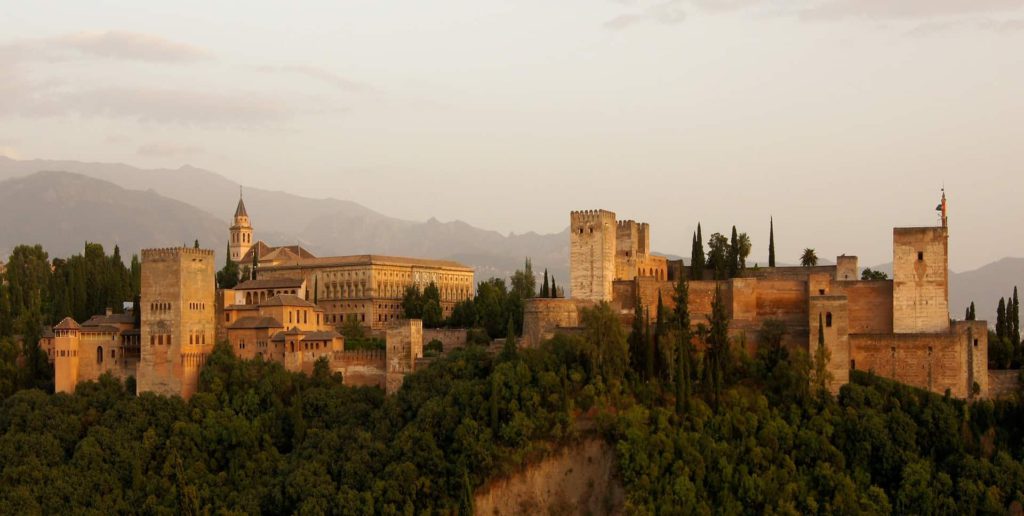Granada is a capital city of the province of the same name, located in the center of the Vega de Granada region, at an altitude of 680 m. above sea level, in the Autonomous Community of Andalusia. Irrigated by the fourth longest river in Spain, Genil River, and by the foothills of the highest massif of the Iberian Peninsula, Sierra Nevada (3,479 meters) that conditions its climate.
Homeland of many famous people in the world of arts and sciences. Among them;
The doctor, poet and translator Judah Ben Saul Ibn Tibbón (1120-1190), considered the father of the translators.
The composer Manuel de Falla.
The poet Federico García Lorca
Granada was also the homeland of Sultan Muhammad XII, better known as Boabdil, when he handed over the city keys to the Catholic Monarchs in 1492. Last Muslim stronghold of the Iberian Peninsula.
The greatest artistic wealth of Granada is Hispano-Muslim art and, especially, the palatine city of the Alhambra and the Generalife. The latter is a recreational palace with a garden plant currently romantic, notable both for its location and layout and for the diversity of flowers, plants and water games. The Alhambra is the culmination of Nasrid art, a work that took place in the thirteenth and fourteenth centuries.
The University of Granada (UGR), founded in 1531 by Carlos I, meant the continuation of higher studies in La Madraza, when the city was the capital of the last Nasrid Kingdom. The University of Granada has become internationally recognized in all university fields: teaching, research, cultural and services to its members and its surroundings, which is why it is one of the destinations that receives more exchange students from the Erasmus Program and one of the most attractive universities for foreign students.
Granada is almost a magical city by combining its artistic and historical heritage with a dynamic of our days.
In Granada there is a wide program of leisure and entertainment, which covers a large number of fields, available to both visitors and citizens themselves. Of the leisure activities carried out, the following can be highlighted:
The zambras of Sacromonte. Old wedding parties held by the gypsies of the city, and which disappeared for years before their current vindication. They develop in the caves of the Sacromonte neighborhood and have a unique character in the world of flamenco. There are also more classic flamenco shows in the Albaicín. These flamenco shows, usually linked to restaurants, are one of the city’s cultural attractions.
Festivals Granada has a very complete range of events: International Music and Dance Festival, International Jazz Festival, Granada Festival South Cinemas and International Tango Festival, among others.
Concerts. Throughout the year there is a stable program of concerts in the Manuel de Falla Auditorium and theater and opera performances in the Palacio de Congresos.
Parties. Throughout the year several parties are held on significant dates for religious, civil or cultural reasons.
For years the city has become a favorite place for young people. The Spring and Cross parties are the greatest expressions of the youth movement.
The gastronomy of Granada is part of the Arabigo-Andalusian cuisine tradition, with a strong Arab and Jewish heritage, which is reflected in its condiments and spices, such as cumin, coriander, nutmeg, cinnamon, raisins, almonds or honey.
The climatic differences of the different regions of the province, from the coast to the peaks of the Sierra Nevada, passing through the fertile plain, propitiates a great variety of raw materials: vegetables, hunting, meats and sausages, fish that are combined in a multitude of dishes and recipes for soups and stews.
The famous and reputed Trevélez ham (jamon)comes from the mountains of Granada. to which other pig derivatives are joined, sausages such as chorizo and loin.
The pastry is well represented in the gastronomy of Granada, for sweets prepared by the nuns that can be purchased in the numerous convents of the city.
Tapas is a deep-rooted and traditional activity among the people of Granada and that always surprises its visitors. There are different tapas routes around the city that allow you to enjoy the most selected of their cuisine. Unlike in other provinces of Andalusia, in Granada tapas are usually free.
Granada is an incoming city with a large number of visitors, both national and international, thanks to its extensive artistic-monumental, cultural and ethnological heritage, including its Spring Festival (Holy Week and Corpus Christi).
There is also an important sports tourism as a result of the existence of an important ski resort in Pradollano, Sierra Nevada (See our monographic post on Sierra Nevada).
Granada has an Exhibition and Congress palace located in a central area of the city; It is 15 kilometers from the airport and has good access from the ring road. It has a useful area of more than 45,000 m², built on seven levels organized to allow the development of different and simultaneous activities. Its facilities are equipped with advanced technologies, typical of this type of buildings, which makes it suitable for all kinds of events and conferences.
Iberinbound, incoming travel agency in Granada, iberinbound@iberinbound.com we are a leading incoming travel agency for Student and Educational Tours providing tailor-made trips at lowest rates. Thanks to our long experience, we have special rates for accommodation and visits for students groups. Each year hundreds of students are travelling with us.
As budget is an important aspect for student groups, we can offer accommodation that fits their needs. We have a variety of hotels and hostels for all destinations and for all ages.
International Airport. Federico García Lorca Granada-Jaén Airport (GRX), is located 17 km west of the city, in the town of Chauchina, It is the fourth largest international airport in Andalusia in number of passengers and cargo, so it facilitates access from all parts of Europe.


